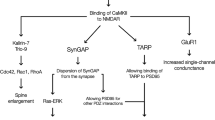Abstract.
Long-term potentiation (LTP) and long-term depression (LTD) are two electrophysiological models that have been studied extensively in recent years as they may represent basic mechanisms in many neuronal networks to store certain types of information. In several brain regions, it has been shown that these two forms of synaptic plasticity require sufficient dendritic depolarization, with the amplitude of the calcium signal being crucial for the generation of either LTP or LTD. The rise in calcium concentration mediated by the N-methyl-d-aspartate (NMDA) subtype of glutamate receptors has been proposed to stimulate various calcium-dependent enzymatic processes that could convert the induction signal into long-lasting changes in synaptic structure; protein kinases and phosphatases have so far been considered predominantly with regard to LTP and LTD formation. According to several lines of experimental evidence, changes in synaptic function observed with LTP and LTD are thought to be the result of modifications of postsynaptic currents mediated by the α-amino-3-hydroxy-5-methyl-4-isoxazole propionate (AMPA) subtype of glutamate receptors. Moreover, it has become apparent recently that activation of the calcium-dependent enzyme phospholipase A2 (PLA2) could be part of the molecular mechanisms involved in alterations of AMPA receptor properties during long-term changes in synaptic operation. In the present review, we will first describe the results that indicate a critical role of the phospholipases in regulating synaptic function. Next, sections will be devoted to the effects of PLA2 and phospholipids on the binding properties of glutamate receptors, and a revised biochemical model will be presented as an attempt to integrate the PLA2 enzyme into the mechanisms (in particular kinases and phosphatases) that participate in adaptive neural plasticity. Finally, we will review data relevant to the issue of selective changes in AMPA binding after environmental enrichment and LTP.
Similar content being viewed by others
Author information
Authors and Affiliations
Rights and permissions
About this article
Cite this article
Massicotte, G. Modification of glutamate receptors by phospholipase A2: its role in adaptive neural plasticity. CMLS, Cell. Mol. Life Sci. 57, 1542–1550 (2000). https://doi.org/10.1007/PL00000639
Issue Date:
DOI: https://doi.org/10.1007/PL00000639




